At the heart of enhancing operational efficiency lies the decision to select the right IT Service Management (ITSM) solution. As you embark on this journey, conducting a comprehensive evaluation of two key players, EasyVista vs. ManageEngine, becomes essential.
In this blog post, we're diving deep into an insightful ITSM tool comparison between these two service desk software platforms. However, amidst this competitive landscape, a compelling alternative deserves your attention: InvGate Service Management. With its streamlined features and forward-looking approach, this tool offers organizations a unique opportunity to elevate their IT operations.
Table of contents
- TL;DR
- What is EasyVista?
- What is ManageEngine?
- Considering InvGate Service Management as an ITSM solution alternative
TL;DR
- EasyVista shines with its intuitive user interface and powerful workflow editor, capturing the attention of users. However, concerns have been raised about inconsistent support from vendors and the platform's complexity, which can lead to time-consuming tasks.
- ManageEngine has gained widespread acclaim for its expansive product range and remarkable growth. However, it has come to light that its integrations beyond the Zoho Ecosystem may have certain limitations, raising concerns about potential vulnerabilities. In a major setback during 2023.
- InvGate Service Management distinguishes itself in the realm of ITSM and ESM with its exceptional ticketing system, user-friendly options, comprehensive reporting features, and unmatched cost-effectiveness.
We tried to be as thorough as possible, but if you don't have enough time to read it through and through, here's (another) TL;DR: InvGate Service Management can do everything we say here, and you can test it right away for free for 30 days.
Most looked-at features by buyers
When assessing IT Service Management solutions, potential buyers often concentrate on specific features that align with their organization's needs. Understanding these desired functionalities is crucial for making well-informed decisions.
Let's explore the key elements prospective buyers typically consider when comparing ITSM tools.
- User-friendly experience and interface - Ease of use and interface design are paramount for buyers. They value a user-friendly platform with an intuitive interface that boosts user adoption and productivity. Mobile accessibility is also crucial for organizations with remote or mobile workforces.
- Ticket Management System - Prospective buyers attach significant importance to a comprehensive Ticket Management system within the help desk software. This feature enables efficient tracking, assignment, and resolution of customer inquiries and support requests.
- Self-service portal and knowledge base - A self-service portal is highly valued as it empowers end-users to independently resolve common issues and access relevant information without direct assistance.
- Scalability and personalization - Organizations with evolving needs prioritize solutions that can adapt to their growth and allow customization. Buyers look for the ability to create custom fields, workflows, and extensions/plugins to cater to their specific business requirements.
- Simplified IT service catalog - Organizations often require a streamlined IT service catalog that provides a centralized platform for users to request specific IT services or resources. This simplifies service requests, improves visibility, and aids in effective service delivery management.
- Customization and adaptability - Buyers appreciate software solutions tailored to their business needs. This ensures the software aligns with their unique workflows and processes, increasing user satisfaction and overall efficiency.
- Seamless integration capabilities - The ability to integrate with other systems and applications is a vital requirement for buyers. They seek seamless data flow and automated processes, placing value on the capability to integrate with existing tools and platforms to enhance efficiency and provide a unified user experience.
- Support automation and Workflow Management - Buyers actively seek software solutions offering automation capabilities to streamline routine tasks such as ticket routing, approvals, and escalations. These automation features contribute to enhanced efficiency and productivity.
- Informative reporting - Buyers seek help desk software with robust reporting tools like dashboards and reports. These features provide valuable insights into IT operations and performance, facilitating informed decision-making and continuous service improvement.
- Cost and support - Buyers assess the solution's cost-effectiveness, including licensing models, subscription plans, and additional costs for features or users. Reliable customer support, comprehensive documentation, and accessible training resources also influence their decision-making process.
- Efficient IT Asset Management - Users prioritize software that offers robust IT Asset Management (ITAM) capabilities. This helps them maintain accurate inventories and optimize resource utilization within their organizations.
- ITIL compliance - Adhering to ITIL best practices is a priority for many organizations. Buyers may prioritize solutions that support ITIL processes, including Incident Management, Problem Management, Change Management, and Asset Management.
What is EasyVista?
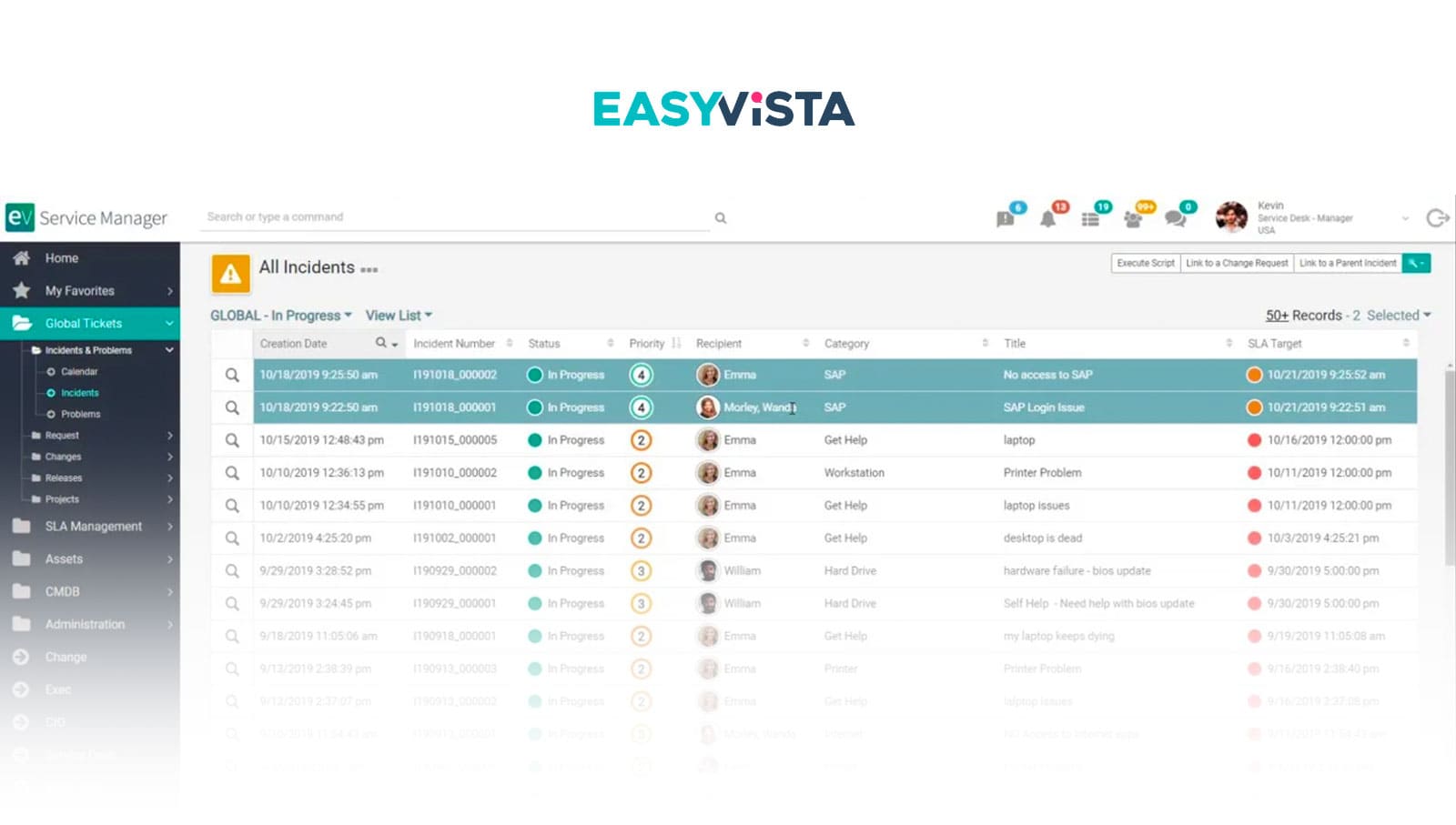
EasyVista is a cloud-based tool that simplifies and improves how IT Service Management tasks are handled. It incorporates 11 ITIL PinkVerified processes, which helps organizations operate more efficiently and consistently.
Previously known as Staff & Line Group, EasyVista is a privately owned company that has been a significant player in the ITSM industry since it was founded in 1988. Its inclusion in the 2022 Gartner Magic Quadrant™ for ITSM Tools underscores its importance and reputation within the ITSM field.
What users like from EasyVista
EasyVista has garnered favorable assessments from reputable industry sources, including Gartner. To better understand the platform's capabilities, let's explore some of the key strengths users emphasized in these evaluations.
- Workflow editor excellence - One standout feature of EasyVista is its workflow editor, which effectively translates documented processes into actionable steps. Users appreciate its low-code options and extensive customization capabilities, making it a versatile tool for tailoring workflows to meet specific requirements.
- Comprehensive ITSM features - EasyVista offers a wide range of IT Service Management features, including robust service catalog management. Users highlight the platform's high flexibility, especially when automating business processes. It supports the centralization, traceability, and visibility of actions, significantly enhancing overall ITSM capabilities.
- Configuration and customization simplicity - EasyVista's codeless configuration simplifies the customization process. Users have found that the platform's groups, roles, and domains streamline ticket assignment, resulting in improved efficiency. Regular updates driven by customer feedback ensure the platform remains up-to-date and responsive to evolving needs.
- User-friendly interface - EasyVista has a user-friendly interface that caters to a wide audience, including customers, IT staff, and administrators. Its incorporation of all ITIL modules adds substantial value to the platform. Users have noted that EasyVista contributes to smoother service processing and enhanced service quality, making it a solution focused on user satisfaction.
- Enhanced efficiency - EasyVista excels in enhancing work efficiency. It offers support services for agility and consistently delivers high-quality results. These efficiency-focused features contribute to overall productivity and performance improvements.
What users don’t like from EasyVista
Although EasyVista possesses several strengths and positive attributes, there have been user apprehensions and criticisms from specific platform aspects. These insights have been gathered from reviews conducted by sources like Gartner. Here are some of the issues that have garnered attention.
- Usability and interface - Some users have found that EasyVista requires an excessive number of clicks to perform common tasks, resulting in time-consuming interactions. The platform has been criticized for its lack of intuitiveness, making it challenging to locate certain features. Users have observed that the default back-office setup is complex and often necessitates customization to streamline the interface.
- Complexity - Users have discovered that fully leveraging EasyVista's features requires a solid grasp and understanding of the platform, which can be a barrier for some users. The application builder is viewed as less user-friendly, particularly for administrators who may find it challenging to navigate and use effectively.
- Functionality and customization - Users have reported that it takes time to configure EasyVista's functionalities fully. They have expressed frustration with the limited customization options available for screen elements, restricting their ability to tailor the platform to their needs. Slowness in the platform's performance, particularly when dealing with a large number of users, has also been noted.
- Integration and modern technologies - EasyVista has faced criticism for its lack of modern technologies and for not meeting expectations regarding its SaaS version and integration capabilities with other tools. Users frequently seek more advanced integration options and a smoother experience when working with external tools.
- Support and documentation - Users have expressed concerns about inconsistent vendor support, which they consider a significant drawback. Additionally, they have noted that the vendor's documentation is both lacking and outdated, hindering their ability to effectively utilize the platform. Furthermore, difficulties in applying updates have been attributed to insufficient vendor quality assurance and quality control (QA/QC) processes.
What’s EasyVista’s argument over ManageEngine?
EasyVista holds several key advantages over ManageEngine, making it a compelling choice for organizations seeking a versatile, user-centric ITSM solution:
- Workflow editor excellence - EasyVista's workflow editor offers low-code options and extensive customization, making it superior for tailored Process Management.
- Comprehensive ITSM features - EasyVista excels in IT Service Management with flexibility and robust Service Catalog Management, enhancing overall ITSM capabilities.
- Configuration simplicity - EasyVista's codeless configuration simplifies customization and streamlines ticket assignment for improved efficiency.
- User-friendly interface - EasyVista's user-friendly design and ITIL integration contribute to smoother service processing and enhanced service quality.
- Enhanced efficiency - EasyVista prioritizes efficiency, supporting agility, and consistently delivering high-quality results.
What is ManageEngine?
ManageEngine, founded initially as AdventNet Inc. in 1996, underwent a rebranding in 2009 and is now recognized as Zoho Corporation. Operating as a part of Zoho Corporation, ManageEngine specializes in delivering comprehensive IT Management solutions tailored to businesses of varying sizes, primarily focusing on small to midsize enterprises.
With its headquarters in Pleasanton, California, ManageEngine maintains a substantial global presence, serving over 180,000 customers worldwide. The company offers ServiceDesk Plus, a platform available for both cloud-based and on-premise deployment options. This platform encompasses a wide range of functionalities, including IT Service Management and IT Asset Management. In the Magic Quadrant assessment, ManageEngine holds the status of a Challenger.
What users like from ManageEngine
ManageEngine has earned accolades from its customers, with positive reviews from reputable sources such as Gartner. Let's delve into some of the notable benefits highlighted by these satisfied customers.
- Diverse product portfolio - ManageEngine has a comprehensive array of complementary products, spanning endpoint management, network monitoring, application monitoring, and active directory management solutions. Additionally, harnessing the low-code development capabilities and business integrations provided by its parent company, Zoho, empowers ManageEngine to offer a broad spectrum of platform functionalities and seize cross-selling opportunities.
- Competitive pricing - ManageEngine distinguishes itself with its cost-effective IT Service Management offerings, featuring a variety of pricing options tailored to different budget requirements. This affordability appeals to mid-sized businesses and larger enterprises in search of value-driven solutions.
- Impressive growth - The platform demonstrates significant growth potential, as evidenced by its flexible deployment options and successful positioning in the midmarket sector. In 2021, the company achieved remarkable revenue growth and expanded its customer base, particularly excelling in the enterprise realm.
What users don’t like from ManageEngine
While ManageEngine has several strengths and positive attributes, customers have also expressed reservations and dislikes about certain platform aspects. Below are some areas of customer concern as identified through reviews from sources like Gartner.
- Limited integrations beyond the Zoho ecosystem - The platform's integrations and extensibility are most robust when combined with other ManageEngine and Zoho ecosystem products. This may pose challenges for customers seeking seamless integration with popular IT Operations Management (ITOM) tools outside of the Zoho ecosystem, potentially requiring them to create custom API connections.
- Limited product innovation - ManageEngine primarily focuses on enhancing processes, integrating with other systems, and offering customization support rather than pushing the boundaries of product innovation. Although the company has introduced some artificial intelligence/machine learning (AI/ML) capabilities, such as field and template recommendations, it still lags behind more advanced products in this regard.
- Security vulnerabilities - In 2023, ManageEngine faced a significant setback when two critical vulnerabilities were discovered across 24 of its products. These vulnerabilities received a severity rating of 9.8 out of 10, as they had the potential to enable remote execution of malicious code. However, the company promptly addressed the situation by releasing patches to mitigate the vulnerabilities and strengthen its security measures.
- Unclear ITSM differentiation in marketing - ManageEngine's marketing efforts often fall short in highlighting its unique value proposition in the IT Service Management (ITSM) market. By predominantly emphasizing common themes like low-code development, customer privacy, and deployment flexibility, the company struggles to distinguish itself from more seasoned competitors in the market.
What’s ManageEngine’s argument over EasyVista?
When comparing ManageEngine to EasyVista, ManageEngine presents several compelling advantages that set it apart:
- Diverse product portfolio - ManageEngine offers a wide range of products, including endpoint management, network monitoring, application monitoring, and active directory management solutions. This breadth is complemented by the low-code development capabilities and business integrations from its parent company, Zoho.
- Competitive pricing - ManageEngine provides cost-effective ITSM solutions with pricing options to suit various budgets, making it appealing to mid-sized businesses and larger enterprises.
- Impressive growth - ManageEngine exhibits strong growth potential, evidenced by flexible deployment options and successful penetration in the midmarket and enterprise sectors. In 2021, the company achieved significant revenue growth and expanded its customer base.
Considering InvGate Service Management as an ITSM solution alternative
While EasyVista and ManageEngine are well-known players in the ITSM industry, exploring alternative solutions tailored to your organization's specific needs is essential. In this context, InvGate Service Management is a compelling option deserving thorough consideration.
Now, let's dive into the comprehensive features of InvGate Service Management that make it a valuable choice for addressing your organization's ITSM requirements:
Strong self-service capabilities
InvGate Service Management offers robust self-service functionalities, including a user-friendly portal, an extensive IT service catalog, and a knowledge base. These features empower end-users to independently address common issues, access various IT services, and utilize self-help resources, thereby reducing the workload on IT staff.
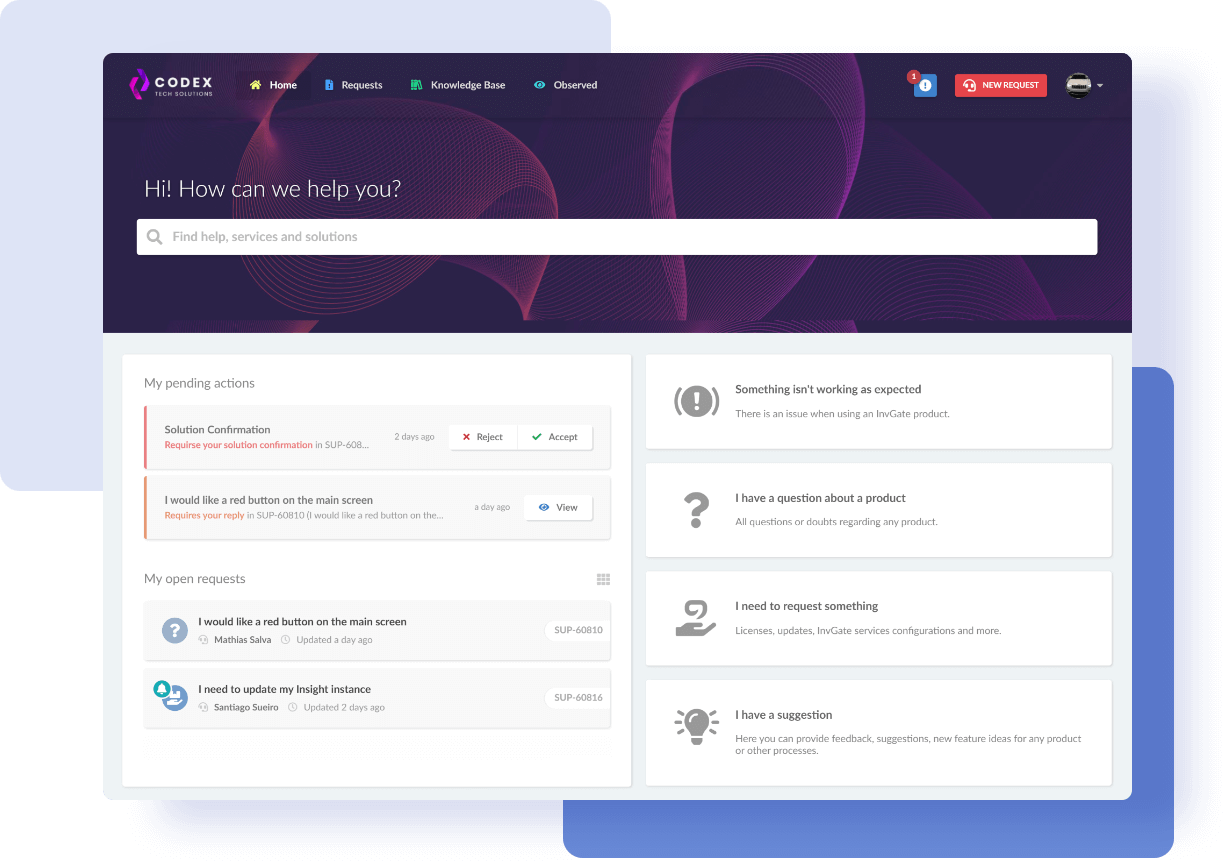
Robust Ticketing and Incident Management
InvGate Service Management offers powerful capabilities for efficiently tracking, collaborating, and resolving tickets. Features like automated ticket routing, customizable workflows, and SLA Management enable IT teams to manage and prioritize incidents effectively.
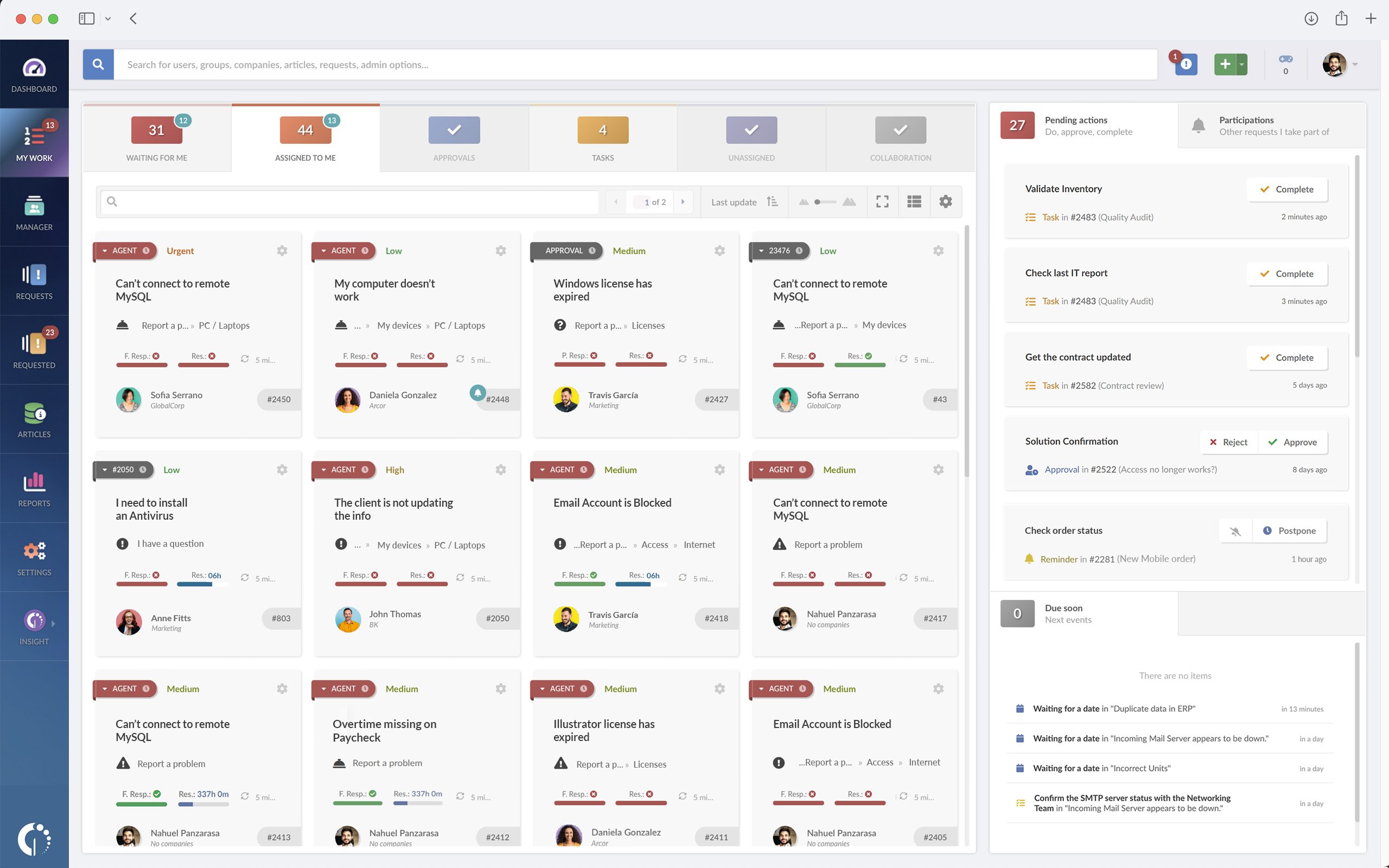
Exceptional user experience
InvGate Service Management places a strong emphasis on delivering an exceptional user experience. This is achieved through meticulous design and adherence to UI/UX best practices. Its intuitive interface encourages rapid adoption and minimizes the need for extensive training, ensuring a user-friendly design that maximizes productivity.
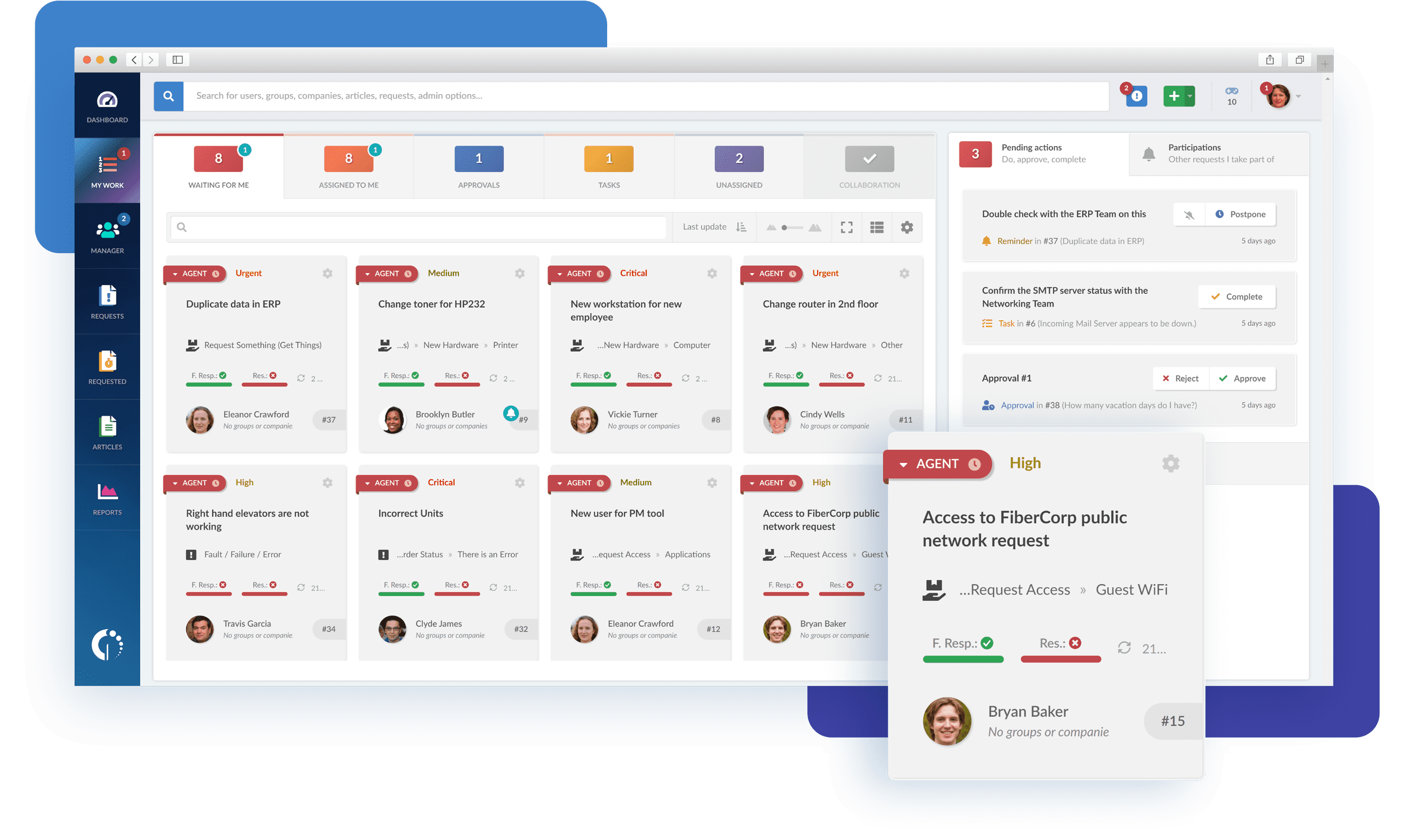
Simplified configuration and setup
InvGate Service Management streamlines configuration and setup through a user-friendly, no-code/low-code approach. Both novices and experienced users can implement the system without requiring extensive technical expertise. The platform provides straightforward configuration options, enabling organizations to harness its potent ITSM capabilities quickly.
Customization and flexibility
InvGate Service Management provides flexible deployment options, allowing organizations to choose between on-premise or cloud-based solutions. This adaptability ensures that the platform can accommodate the unique requirements of diverse sectors and industries.
Cost-effective solution
InvGate Service Management offers a cost-effective solution without compromising functionality. It provides a comprehensive suite of ITSM features at a competitive price point, making it an appealing choice for organizations seeking affordability without sacrificing capabilities. Compared to alternatives like EasyVista and ManageEngine, InvGate Service Management strikes a balance between cost and functionality.
Comprehensive Asset Management
By integrating InvGate Service Management with InvGate Asset Management, organizations gain a comprehensive view of their IT ecosystem. This results in improved service delivery and reduced downtime. InvGate Asset Management offers features such as IT Asset Discovery, Inventory Management, Software License Management, and maintenance schedules.
ITIL best practice compliance
InvGate Service Management has earned the prestigious PinkVERIFIED Certified certification, demonstrating its commitment to upholding ITSM excellence. Whether organizations are starting their ITIL journey or managing complex operations, InvGate Service Management offers a user-friendly and feature-rich experience aligned with industry best practices.
Comprehensive reporting and analytics
InvGate Service Management provides extensive reporting and analytics functionalities, enabling organizations to gain valuable insights into their IT operations and performance. The platform offers ready-to-use reports and customizable dashboards, empowering IT teams to analyze data, identify patterns, and make informed decisions to enhance their services.
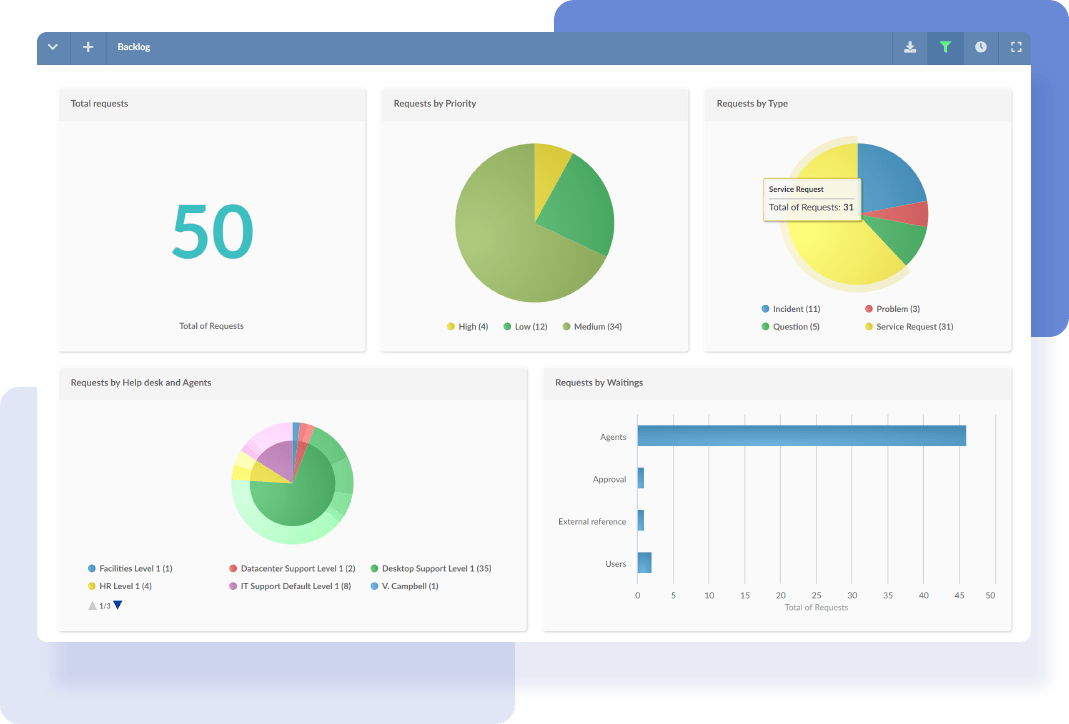
Focused on ITSM with ESM extension
InvGate Service Management is designed specifically for ITSM and seamlessly extends its capabilities to Enterprise Service Management (ESM). This allows operational departments to enhance their processes and fully embrace the benefits of digital transformation. With a primary focus on ITSM and strong performance in ESM, InvGate Service Management facilitates streamlined workflows and comprehensive digital transformation initiatives across all departments.
Fast ROI and ongoing innovation
InvGate Service Management ensures a swift return on investment through efficient implementation processes. Within weeks, organizations can begin reaping the benefits of this robust ITSM solution. Additionally, regular feature updates keep users at the forefront of technology without incurring additional costs.
Next steps
In the ongoing debate of EasyVista vs. ManageEngine for your IT Service Management needs, we've delved into the strengths and advantages of each platform. This decision carries substantial weight, directly impacting your organization's IT services and overall efficiency.
However, the dynamic landscape of ITSM solutions continually introduces new contenders into the mix. That’s why keeping an open mind and exploring alternatives that align precisely with your unique business requirements is crucial.
One such standout option is InvGate Service Management. With its streamlined functionalities, this platform offers organizations a distinct opportunity to elevate their IT operations. It's more than just a service desk – it's a fuel for operational excellence.
Request 30-day free trial and empower your business for success.
















